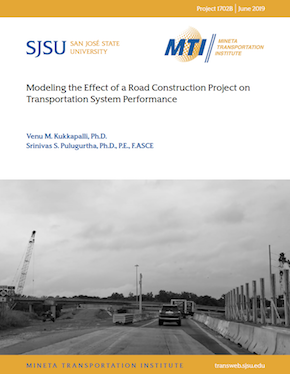- 408-924-7560
- mineta-institute@sjsu.edu
- Donate
Modeling the Effect of a Road Construction Project on Transportation System Performance
Road construction projects create physical changes on roads that result in capacity reduction and travel time escalation during the construction project period. The reduction in the posted speed limit, the number of lanes, lane width and shoulder width at the construction zone makes it difficult for the road to accommodate high traffic volume. Therefore, the goal of this research is to model the effect of a road construction project on travel time at road link-level and help improve the mobility of people and goods through dissemination or implementation of proactive solutions.
Data for a resurfacing construction project on I-485 in the city of Charlotte, North Carolina (NC) was used evaluation, analysis, and modeling. A statistical t-test was conducted to examine the relationship between the change in travel time before and during the construction project period. Further, travel time models were developed for the freeway links and the connecting arterial street links, both before and during the construction project period. The road network characteristics of each link, such as the volume/ capacity (V/C), the number of lanes, the speed limit, the shoulder width, the lane width, whether the link is divided or undivided, characteristics of neighboring links, the time-of-the-day, the day-of-the-week, and the distance of the link from the road construction project were considered as predictor variables for modeling.
The results obtained indicate that a decrease in travel time was observed during the construction project period on the freeway links when compared to the before construction project period. Contrarily, an increase in travel time was observed during the construction project period on the connecting arterial street links when compared to the before construction project period. Also, the average travel time, the planning time, and the travel time index can better explain the effect of a road construction project on transportation system performance when compared to the planning time index and the buffer time index. The influence of predictor variables seem to vary before and during the construction project period on the freeway links and connecting arterial street links. Practitioners should take the research findings into consideration, in addition to the construction zone characteristics, when planning a road construction project and developing temporary traffic control and detour plans.
VENU M. KUKKAPALLI, PhD
Dr. Venu Madhav Kukkapalli completed his PhD in Infrastructure and Environmental Systems at the University of North Carolina at Charlotte. Before joining the PhD program, he worked as a Junior Transportation Planner at SLS TTIC Pvt. Ltd, Bangalore India. He earned his master’s degree from National Institute of Technology, Trichy, India. His areas of interest are transportation planning and traffic safety. Currently, he is working as Transportation Engineer at Transcend Engineers & Planners LLC, Texas.
SRINIVAS S. PULUGURTHA, PhD, PE, F.ASCE
Dr. Srinivas S. Pulugurtha, PE, F.ASCE is currently working as Professor & Research Director of the Department of Civil & Environmental Engineering at The University of North Carolina at Charlotte (UNC Charlotte). He teaches graduate as well as undergraduate courses and conducts research in the transportation engineering field. He is also currently directing the Infrastructure, Design, Environment, and Sustainability (IDEAS) Center on UNC Charlotte campus. Prior to his appointments at UNC Charlotte, Dr. Pulugurtha worked as Assistant Director and Assistant Research Professor of the University of Nevada, Las Vegas - Transportation Research Center (UNLV-TRC), from September 1998 to August of 2005. Dr. Pulugurtha has experience working in diverse fields of transportation. They include traffic safety, Intelligent Transportation Systems (ITS), transportation system planning, Geographic Information Systems (GIS) applications, data analytics and visualization, Internet applications, traffic operations, and, artificial intelligence (AI) techniques and operations research applications. During his 25-year tenure as a researcher, Dr. Pulugurtha has led and completed over 70 sponsored projects as Principal Investigator or co-Principal Investigator. He authored / co-authored over 250 publications (includes 70 journal papers). He also made over 150 technical presentations at international, national, regional and local conferences.
-
Contact Us
San José State University One Washington Square, San Jose, CA 95192 Phone: 408-924-7560 Email: mineta-institute@sjsu.edu






